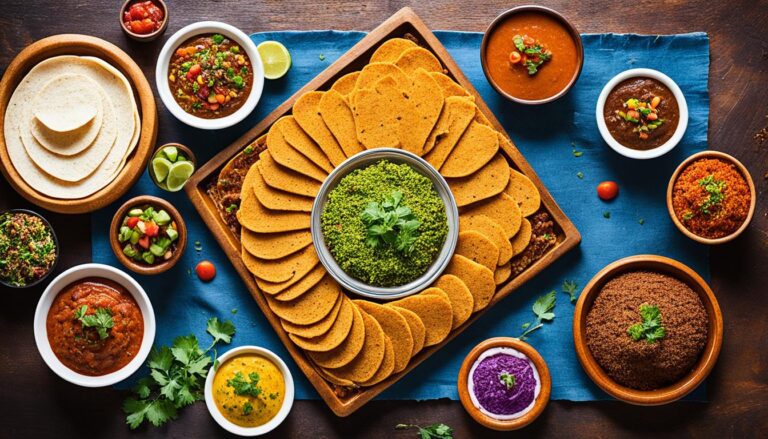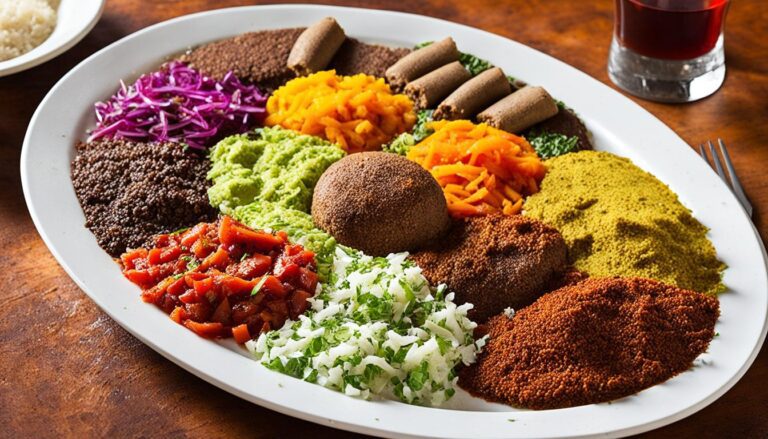What to Order Ethiopian Food?
Are you ready to embark on a culinary journey like no other? Ethiopian cuisine offers a tapestry of flavors and aromatic spices that will transport your taste buds to a whole new world. But with so many delicious options to choose from, how do you know what to order?
From the tangy injera to the rich stews and vibrant vegetarian dishes, Ethiopian food is a celebration of bold flavors and communal dining. Whether you’re a seasoned fan or a curious newcomer, this guide will help you navigate the menu of an Ethiopian restaurant and discover the must-try dishes that will leave you craving for more.
So, are you ready to explore the depths of Ethiopian cuisine and indulge in a truly unforgettable dining experience? Let’s dive in!
Key Takeaways
- Ethiopian cuisine offers a unique and flavorful experience that is worth exploring.
- Injera, a sour fermented flatbread, is a staple in Ethiopian cuisine.
- Popular Ethiopian dishes include Tibs Wat (beef cooked in Berbere sauce) and Doro Wat (chicken cooked in spicy sauce).
- When dining at an Ethiopian restaurant, consider going with a group to try a variety of dishes.
- Eating with your hands using injera is a common practice in Ethiopian cuisine.
Exploring Ethiopian Cuisine
Injera is a staple in Ethiopian cuisine, a fermented flatbread made from teff, a type of grass. It has a sour taste and is often served with various toppings and accompaniments.
One popular Ethiopian restaurant in New York City is Awash, where you can find dishes like Tibs Wat (beef cooked in Berbere sauce), Key Sir Alicha (beets, carrots, and potatoes cooked to juiciness), and Doro Wat (chicken cooked in a spicy Berbere sauce). Another Ethiopian restaurant, Abyssinia, offers a variety of dishes like Doro Tibs (marinated chicken breast), Tikil Gomen (cabbage cooked with vegetables), and Fossolia (string beans and carrots in garlic sauce).
Tips for Ordering and Eating Ethiopian Food
When dining at an Ethiopian restaurant, we recommend going with a group to try a variety of dishes by sharing. It’s a great way to experience the diverse flavors of Ethiopian cuisine. However, if you’re dining alone, don’t worry! There are still plenty of options for you to enjoy.
One popular choice for solo diners is ordering a Beyaynetu, a vegetarian combination platter. This allows you to sample a variety of veggie dishes and explore the rich flavors of Ethiopian cuisine. From lentils and cabbage to spiced potatoes and greens, the Beyaynetu offers a satisfying and nutritious meal.
For meat lovers, Ethiopian cuisine has delicious options as well. Ethiopian meat dishes, such as Doro Wot (chicken) and Siga Wot (beef), are known for their tender and lean cuts. They are often cooked in flavorful sauces and spices, creating a mouthwatering experience.
When it comes to spice levels, Ethiopian cuisine strikes a balance between flavor and heat. The dishes are typically well-spiced but not overly spicy. The star of the meal, injera, a sourdough flatbread made from teff, acts as a wonderful complement to the spices. Not only does it serve as a utensil for scooping up the food, but its neutralizing effect helps to balance the spice and enhance the overall taste.
Eating with your hands is also part of the Ethiopian dining experience. Injera serves as both a utensil and a plate. Tear off a small piece of injera, use it to grab a bite of your chosen dish, and enjoy the burst of flavors. The communal act of sharing food and eating with your hands creates a sense of togetherness and adds to the overall enjoyment of the meal.
So, whether you’re visiting an Ethiopian restaurant for the first time or are a seasoned fan, remember these tips for ordering and eating Ethiopian food. Explore the vegetarian options, savor the spice levels, and embrace the cultural tradition of using injera as your utensil.
Ready to tantalize your taste buds with Ethiopian cuisine?
Discover the mouthwatering dishes and unique flavors at your nearest Ethiopian restaurant. Don’t miss out on this culinary adventure!
Drink Choices in Ethiopian Cuisine

In addition to the delicious food, Ethiopian cuisine offers a variety of drink options. From traditional honey wine to locally produced beer and wine, there are plenty of beverages to enhance your Ethiopian dining experience.
Tej: One iconic Ethiopian beverage is tej, a traditional honey wine. Tej has a unique and slightly sweet taste that pairs perfectly with the flavors of Ethiopian dishes. Made by fermenting honey with water and hops, this golden-hued wine offers a delightful balance of sweetness and acidity.
Ethiopian Wine: When it comes to wine, Ethiopia has its own vineyards producing both red and white varieties. Enjoy a glass of Ethiopian wine, and you’ll be treated to the rich flavors and unique characteristics derived from the country’s fertile soil and distinct terroir.
Ethiopian Beer: Beer lovers will appreciate the selection of Ethiopian beer brands available. Meta, Dashen, and St. George are popular Ethiopian beer brands known for their refreshing taste and high-quality ingredients. Whether you prefer a light lager or a bold ale, you’re sure to find a beer that suits your palate.
Exploring these drink options allows you to fully immerse yourself in the vibrant and diverse culture of Ethiopian cuisine. So when you visit an Ethiopian restaurant, be sure to raise your glass and toast to a memorable dining experience!
Embracing Nose-to-Tail Cooking in Ethiopian Cuisine

Ethiopian cuisine is renowned for its bold flavors and diverse range of dishes. One aspect of Ethiopian cooking that sets it apart is its embrace of nose-to-tail cooking, where every part of the animal is utilized. This approach not only reduces waste but also adds depth and richness to the flavors of Ethiopian dishes.
A prime example of this nose-to-tail philosophy is the traditional Ethiopian dish called dulet. Dulet is a unique combination of tripe, liver, and lean meat, delicately seasoned with spices and flavors. By incorporating different cuts of meat and organ meats, dulet showcases the full potential of Ethiopian cooking and highlights the culinary creativity of Ethiopian chefs.
Organ meats, such as tripe and liver, add a distinct richness and complexity to the overall flavor profile of dishes like dulet. These ingredients are skillfully prepared and expertly seasoned to create a dish that is both flavorful and satisfying. Ethiopian cuisine truly celebrates the unique qualities and flavors of organ meats, proving that no part of the animal should go to waste.
For adventurous eaters, exploring the world of Ethiopian cuisine and trying dishes like dulet can be an exciting and memorable experience. The combination of different cuts of meat and the skillful use of spices and flavors result in dishes that are not only delicious but also reflect the culinary traditions and heritage of Ethiopia.
To truly appreciate the artistry and depth of Ethiopian cooking, we encourage you to embrace nose-to-tail cooking and explore dishes like dulet. The bold flavors and unique combinations will take your taste buds on a journey and provide a one-of-a-kind dining experience.
Continue reading to learn more about other aspects of Ethiopian cuisine, including tips for ordering and eating Ethiopian food, drink choices, and a comprehensive guide to exploring this flavorful cuisine.
Conclusion
Exploring Ethiopian cuisine is an exciting journey into a world of flavors and culinary delights. Whether you’re a first-time adventurer or a seasoned fan of Ethiopian food, this guide has provided you with the essential knowledge to confidently order and enjoy a wonderful dining experience.
Don’t miss the opportunity to try injera, the unique and delicious fermented flatbread that is a staple in Ethiopian cuisine. Its sour taste pairs perfectly with the rich stews and vibrant spices that make Ethiopian dishes so distinctive.
By embracing the cultural experience of Ethiopian dining, you’ll not only satisfy your taste buds but also gain a deeper appreciation for the traditions and heritage behind the cuisine. Don’t hesitate to explore the diverse vegetarian and non-vegetarian options available, and be sure to indulge in the nose-to-tail cooking that showcases the bold flavors of organ meats.
So, venture into an Ethiopian restaurant, let your curiosity guide you, and embark on a culinary journey through the flavors of Ethiopia. By trying Ethiopian dishes, you’ll discover a new world of taste sensations and create memories that will last a lifetime.







